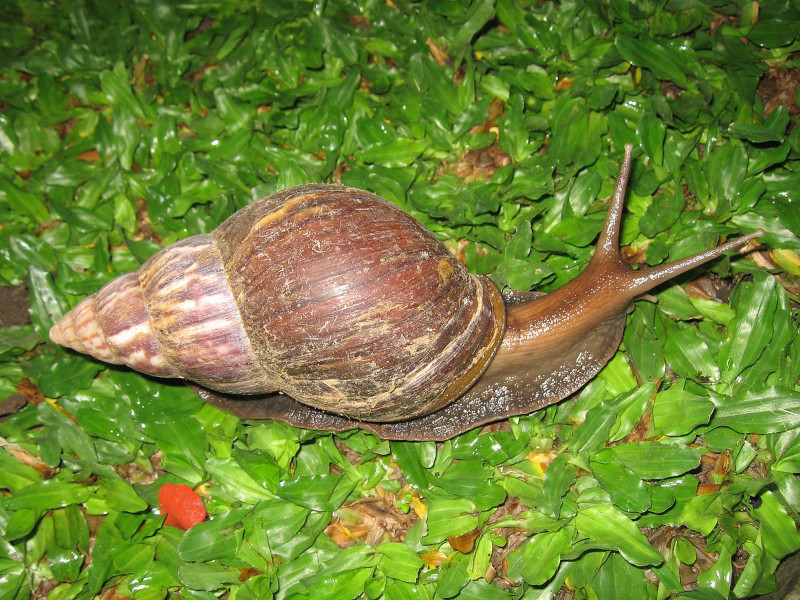
Giant African Land Snail Facts
- This Gastropod most frequently, and appropriately, goes by the informative common name of the Giant African Land Snail. It’s also sometimes simply called the Giant African Snail. Intriguingly, though, it shares that general term with several other species.
- Scientific professionals, meanwhile, generally employ the formal name for the creature when referring to it. That term, however, remains somewhat hard to pronounce, as often happens. That’s because it bears the official name of Lissichatina fulica.
- It received that appellation as a result of the work of the respected French naturalist, Baron André Étienne Justin Pascal Joseph François d’Audebert de Férussac. He accomplished the first formal recognition of it as a separate and distinct species in 1821.
- This impressive invertebrate’s now been spread to many parts of the globe, outside of its natural range. That’s had the unfortunate result of making it an unwelcome fauna in some regions. In fact, it’s now listed as one of the top 100 invasive species in existence.
- The population of the Giant African Land Snail appears to be both stable and sufficient. This especially holds true in its native territory. Yet its numbers within introduced areas also remain impressive. The IUCN, therefore, currently has no Red List listing for it.
- Yet the now controversial creature does face some potential threats to its existence, if current trends continue. Habitat loss poses a possible future danger, understandably. Yet the greatest danger the animal faces likely consists of ongoing climate change.
Related Articles
Giant African Land Snail Physical Description
The Giant African Land Snail, the Lissachaina fulica, boasts some truly impressive physical statistics for a snail. In point of fact, all of the related species that also often go by the same name share very similar, though certainly not identical, attributes in that respect.
In a trait common to many shelled gastropods, this marvel of Nature evolved as hermaphroditic in nature. That means it has both male and female reproductive organs. The physiological characteristic of sexual dimorphism, therefore, does not apply in its case.
Mature adults of the species do tend to vary, sometimes significantly, in size, however. Yet some statistics remains firm. An average adult specimen attains an impressive body length of approximately 8 in (20 cm). These also reach an average diameter of roughly 4 in (10 cm).
That makes it one of the largest of all known land snails still in existence. Its awesomeness doesn’t end there, though. That’s because this creation of evolution reaches an average weight of roughly 1.13 oz (32 g). Apparent size varies, though, as the individual moves.
It also develops a highly intriguing shell. This simply adds to the appeal of the animal, to those who appreciate Nature. The protective structure develops in a strongly cone-shaped pattern. As a general principle, though, its height measures about twice the width.
The Giant African Land Snail has yet another impressive physical quality. That’s in the manner of its coloring. This varies quite widely, based on the surrounding environment. These include shades of dark brown, with stripes, or reddish-brown with yellow markings.
- Kingdom: Animalia
- Phylum: Mollusca
- Class: Gastropoda
- Order: Stylommatophora
- Family: Achatinidae
- Genus: Lissachatina
- Species: L. fulica
Giant African Land Snail Distribution, Habitat, and Ecology
The very name of the Giant African Land Snail provides a clear indication of its natural range of distribution. That’s due to the fact that, as implied by that term, it natively inhabits portions of the continent of Africa. It does not appear naturally in all areas, though.
To be more precise, the invertebrate originally evolved as endemic to only the coastal regions and islands of East Africa. Now, however, the intrepid creature has expanded its range, partly due to the actions of humans, into other portions of the continent.
The snail principally appears from Mozambique, in the south, to Somalia and Kenya in the north, though. The mollusc also evolved as highly adaptable in terms of its habitat requirements. In its native range, it mainly lives in regions possessing tropical-like climates.
Outside of that primary zone of habitation, however, it’s now adapted to numerous temperate climates around the globe. This frequently includes such diverse ecosystems as forests, coastal regions, wetlands, disturbed areas, agricultural zones, and urban areas.
This marvelous gastropod, like its related species, evolved as fully herbivorous in nature. In its case, though, its diet covers a wide range of flora. This includes various vegetables and fruit, fungi and lichens. Yet it also sometimes consumes cardboard and paper!
Being hermaphrodites, reproduction remains somewhat different for the Giant African Land Snail. Individuals do not self-fertilize, as one might expect. Instead, each individual mates with another, with each fulfilling a different gender role from one mating to another.
Species Sharing Its Range
Check out our other articles on 5 Piedmont Region Invertebrates, Rough-nosed Horned-Lizard, Dune du Pilat, Wilson’s Bird-of-paradise, Texas Blind Salamander, Swell Shark, Maned Wolf
